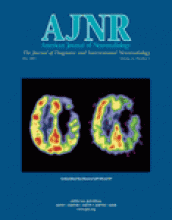Abstract
BACKGROUND AND PURPOSE: Previous reports of outcome with permanent vessel occlusion (PVO) for large, giant, or fusiform aneurysms in the posterior circulation have been limited. We undertook this study to evaluate the perioperative (within 30 days) and follow-up outcomes for patients treated with permanent occlusion of the vertebral artery for vertebrobasilar fusiform and dissecting aneurysms.
METHODS: Thirteen consecutive patients were studied. Two groups were defined for the study. Group I patients underwent PVO to achieve complete thrombosis of the aneurysm. Group II patients underwent PVO to reduce flow to the aneurysm where complete thrombosis was not desirable. Modified Rankin scores were obtained at presentation and at follow-up (follow-up range, 1–76 months; mean, 22.0 months).
RESULTS: All group I aneurysms were shown to be thrombosed on the angiograms obtained at the immediate follow-up examinations. Improvement in outcome scores was achieved by all group I patients. Improvement in Rankin scores after endovascular treatment was statistically significant (P = .026). All group II patients had complete occlusion of the vertebral artery; however, continued filling of the fusiform aneurysm was still observed. Four patients in group II died during the follow-up period. Two of these deaths were attributable to the aneurysms. Of the remaining three patients, two experienced clinical worsening and one remained stable.
CONCLUSION: In this series, PVO for chronic fusiform and acute dissecting aneurysms of the vertebrobasilar system proved to be a useful therapeutic endovascular technique. Long-term outcomes suggest that patients with aneurysms involving only one vertebral artery, where complete thrombosis can be achieved, have better clinical outcomes than those who have aneurysms involving the basilar artery or both vertebral arteries, where complete thrombosis cannot achieved by using PVO.
- Copyright © American Society of Neuroradiology












